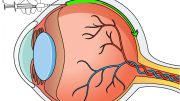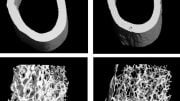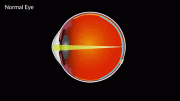
Harmful blood vessel growth in the eye, also known as neovascularization, is a condition in which abnormal blood vessels form in the retina or the front part of the eye. This growth can lead to vision loss and even blindness if not treated promptly.
Scientists at UVA Health have uncovered a previously unknown factor that contributes to the harmful growth of blood vessels in the eye. This breakthrough could pave the way for new treatments for macular degeneration and other common causes of vision loss.
Jayakrishna Ambati, MD, and Shao-bin Wang, Ph.D. of UVA, along with their colleagues, have pinpointed a new target in their efforts to halt the development of abnormal blood vessel tangles associated with eye conditions like neovascular age-related macular degeneration, proliferative diabetic retinopathy, and ischemic retinal vein occlusion.

Jayakrishna Ambati, MD, is the founding director of UVA’s Center for Advanced Vision Science and a member of the University of Virginia School of Medicine’s Department of Ophthalmology. Credit: UVA Health
“Our study has opened up the possibility of mitigating aberrant blood vessel growth in eye diseases by targeting the epigenetic machinery,” said Ambati, the founding director of UVA’s Center for Advanced Vision Science and a member of the University of Virginia School of Medicine’s Department of Ophthalmology.
“Through local targeting of the epigenetic regulator, we have gained a deeper understanding of how ocular immune cells can cause a loss of control over blood vessel growth under the retina. This approach also offers a new direction for the development of more effective, cost-efficient, and accessible interventions, thereby avoiding issues such as drug resistance, which is a growing concern with conventional anti-VEGF therapies used in clinical treatments.”
Understanding Vision Loss
Scientists have known that abnormal vessel overgrowth in the eye is fueled by excessive amounts of a substance called “vascular endothelial growth factor-A,” or VEGF, that plays an important role in blood vessel formation. There are now treatments available that target VEGF to prevent vessel overgrowth, and they often provide dramatic benefits at first. Unfortunately, these benefits can fade with time. That leaves doctors in need of better treatments to help preserve patients’ eyesight.
Ambati and Wang’s new research identifies a key protein that determines VEGF levels. Blocking this protein in lab mice reduced their VEGF levels significantly, and it did so in a targeted way, without unwanted side effects. The scientists noted, for example, that they observed no toxic effects on the retina, the light-sensing portion of the eye where the vessel overgrowth occurs.
“This fat mass and obesity-associated (FTO) protein was previously shown to be correlated with obesity in humans. Unexpectedly, we found it also play important roles in regulating ocular neovascularization through an epigenetic mechanism,” Ambati said. “This exciting discovery finally answers a longstanding question about how ocular immune cells, such as macrophages, contribute to abnormal blood vessel growth under the retina. This question was first investigated by our team 20 years ago, and we’re thrilled to have found an answer.”

UVA Health’s Shao-bin Wang, Ph.D. Credit: Shao-bin Wang
In addition to identifying a promising target for the development of new treatments for vision loss, the discovery sheds important light on the fundamental mechanisms responsible for the blood vessel overgrowth that robs millions of people of their sight. Neurovascular age-related macular degeneration alone affects more than 200 million people worldwide. While much more research and testing will be needed before the new finding could be translated into a treatment, the UVA scientists are excited about the potential of the discovery.
“Current strategies for treating ocular neovascular disorders, which primarily focus on regulating the protein levels of VEGF, are not perfect. Therefore, it is imperative to identify more targetable candidates to develop alternative therapies,” Wang said. “We are hopeful that our study will pave the way for the development of new treatments, ultimately reducing the burden of neovascular-related illnesses.”
Reference: “Targeting the m6A mRNA demethylase FTO suppresses vascular endothelial growth factor release and choroidal neovascularization” by Shao-bin Wang, Yosuke Nagasaka, Dionne Argyle, Ayami Nagasaka, Praveen Yerramothu, Bradley D. Gelfand and Jayakrishna Ambati, 20 February 2023, Signal Transduction and Targeted Therapy.
DOI: 10.1038/s41392-022-01277-4
Ambati is a co-founder of DiceRx, iVeena Holdings, iVeena Delivery Systems, and Inflammasome Therapeutics and has done consulting work unrelated to the research. A full list of the authors’ disclosures is included in the paper.
The study was funded by the National Institutes of Health, the UVA Strategic Investment Fund, the DuPont Guerry III professorship, a gift from Mr. and Mrs. Eli W. Tullis, the Annette Lightner Fund, a BrightFocus Foundation Award, and the Owens Family Foundation.









Advance RP tretment
What about RP teraphi